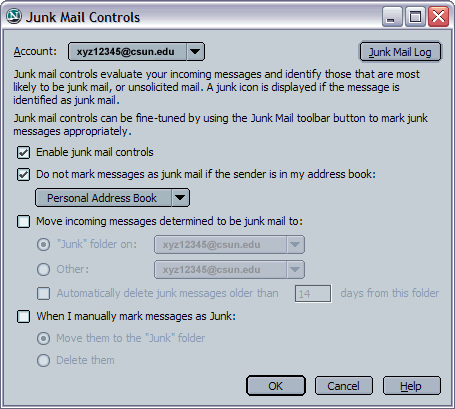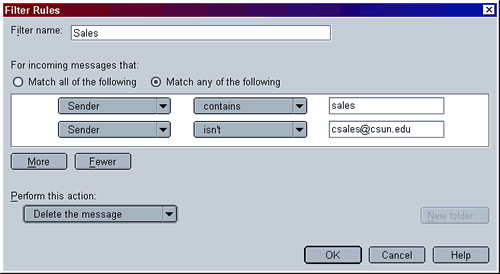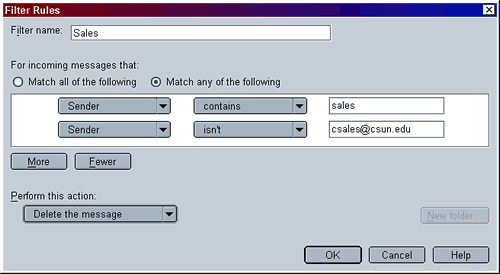
Filtering/Deleting Unwanted Messages in Netscape Mail 7
The filtering capabilities of Netscape Mail 7.0 can be used to delete unsolicited and unwanted email messages — i.e., "junk" mail or "spam". This document describes how. You can use any or all of the methods described.
Note: Message filters can also be used to organize your messages in folders. Deleting unwanted messages is only one example of how the filtering tool might be used.
- Using the Junk Mail Control Feature to Remove Junk Mail
- Deleting Messages Based on Rules You Specify
- Organizing Messages in Folders to Isolate Unwanted Mail
- Modifying and Deleting Filters
- Emptying Trash
Using
Junk Mail Controls to Identify and Remove Junk Mail
(in Version 7.1 or higher)
Beginning with Version 7.1, you can use the Junk Mail Controls feature to train the program to recognize junk mail. Then, when junk mail is consistently identified correctly, you can delete junk mail automatically or move junk mail to the Junk folder.
Training Netscape Mail to Detect Junk Mail
By default
Junk Mail Controls are enabled and all incoming message are analyzed.
Messages sent by anyone in your address book will not be marked as junk,
but until you train the program what is and isn't junk mail, nearly everything
else will be. A junk icon![]() will
appear in the Junk Status column of your mail listing for each message
that is considered to be junk. If a message is incorrectly marked, simply
click the Junk icon next to the message to remove it. When you no longer
have to correct the program, you'll know it's fully trained.
will
appear in the Junk Status column of your mail listing for each message
that is considered to be junk. If a message is incorrectly marked, simply
click the Junk icon next to the message to remove it. When you no longer
have to correct the program, you'll know it's fully trained.
Deleting Junk Mail or Moving It to the Junk Folder
During the training phase, you can delete messages marked as Junk by selecting Delete Mail Marked as Junk in Folder from the Tools menu.
When you're ready to let Netscape Mail dispose of junk mail automatically, go to the Tools menu and choose Junk Mail Controls. Make selections in the dialog box that appears (see Figure 1, below). You can specify where to move mail identified as Junk. You can also tell the program to delete junk mail messages after some specified number of days (14 days is the default).
FIGURE 1. Junk Mail
Controls Dialog Box

How to Learn More about Junk Mail Controls
Use Netscape Mail's Help feature to learn more about the Junk Mail Controls. From the Help menu, choose Help and Support Center. The Search tab provides an easy way to search for a topic. Enter junk mail in the search text box and then click the Go button to locate information about using Junk Mail Controls.
Deleting Messages Based on Rules You Specify
To delete messages based on rules you specify, do the following:
- From the Tools menu, choose Message Filters… to display the "Message Filters" dialog box.
- Click the New… button to display the "Filter Rules" dialog box. It is here that you'll set the criteria for filtering messages.
- Enter a name for the set of rules you're about to define (such as Junk Mail) in the "Filter name:" text box.
- The
middle portion of the dialog box is where you enter the filtering criteria.
- Choose (click)the appropriate radio button to match ANY or ALL of the criteria you specify.
- Make a selection from the drop-down menu that initially displays "Subject". From this menu you can specify which component of the email message you want tested by the message filter. Similarly, make a selection from the drop-down menu that initially displays "contains". From this menu you can specify how the filter is to test the message component previously defined. In the text box to the right of the drop-down menus enter the text that defines what the filter is testing.
For example, to delete messages from a number of different sources and containing various subject lines, you'll probably want to choose "Match ANY of the following" (as shown in Figure 1, below). Choose "Match ALL of the following" when you want to refine the specifications — to include exceptions to the rule, for example (as shown in Figure 2, below).
- To
include additional criteria, click the More button (a second
set of drop-down menus and another text box will appear) and repeat
step 4b above.
For example, to also redirect messages with a subject line containing the phrase "HUGE VOLUME TODAY" to the Trash folder, the first drop-down menu would display Subject; the second drop-down menu would display contains; and in the text field HUGE VOLUME TODAY would be entered.
- When finished specifying rules, stipulate what to do if the rules are met. To delete messages select Delete this message from the drop-down menu under "Perform this action:".
- Finally, click the OK button.
For example, to delete all messages coming from a sender called "Greatest Specials", the first drop-down menu would display Subject; the second drop-down menu would display contains; and in the text field Greatest Specials would be entered.
Examples
Two examples of filter rules for deleting unwanted messages are shown in Figures 2 and 3 (below).
In Figure 2, the filter name is "Junk Mail" and the filter criteria specify that if the sender portion of an incoming email message contains the phrase "Greatest Specials" or if the subject portion of an incoming message contains the phrase "HUGE VOLUME TODAY", the message is to be deleted (i.e., moved to the Trash folder).
FIGURE 2. Filter
Rules Example in Which Any Criterion May Be Met |
Figure 3 illustrates a filter rule in which all criteria must be met before an incoming message is sent to the Trash folder. You may want to filter out all unrequested sales pitches but still receive messages from someone you know whose surname is Sales. In the example shown the filter name is "Sales" and the filter criteria specify that if the sender portion of an incoming email message contains the word sales AND the sender of the message isn't csales@csun.edu, the message is to deleted (i.e., moved to the Trash folder).
FIGURE 3. Filter
Rules Example in Which All Criteria Must be Met |
Organizing Messages in Folders to Isolate Unwanted Mail
Rather than deleting mail from a number of distinct sources, you can use another filtering approach to retain messages from known legitimate sources in your inbox (and/or other folders) while filtering everything else into a separate folder. Using this method, you can easily see those messages you know you want to look at. Then, at your leisure, you can peruse the folder containing what may be junk mail — and you can delete all unwanted messages. If you find legitimate messages in the folder, you may want to refine your filters, so that subsequent messages from the same source won't be filed in the "potentially-junk folder".
Examples
Following the instructions for creating a filter as outlined above, you might set criteria as follows.
- If the
only mail you want to read is likely to come from a CSUN campus source,
you can specify:
Match any of the following: the SENDER of the message DOES NOT CONTAIN csun.edu then MOVE TO FOLDER Not CSUN (use the New Folder button to create the "Not CSUN" folder if it doesn't already exist)
- If the
only mail you want to read is likely to come from an American university,
you can specify:
Match any of the following: the SENDER of the message DOES NOT CONTAIN .edu then MOVE TO FOLDER Not EDU (use the New Folder button to create the "Not EDU" folder if it doesn't already exist)
- If you are already filtering messages into folders by topic, sender, or some other organizing principle, you might add one of the above as a final filter.
Modifying and Deleting Filters
To modify an existing filter, do the following:
- From the Tools menu, choose Message Filters.
- In the Message Filters dialog box, highlight the name of the filter to be modified.
- Click the Edit button to display the Filter Rules dialog box.
- Add or delete criteria as desired.
- Click the OK button when finished.
To delete a filter (and all criteria it contains), do the following:
- From the Tools menu, choose Message Filters.
- In the Message Filters dialog box, highlight the name of the filter to be deleted.
- Click the Delete button.
- Click the OK button when finished.
Emptying Trash
Until the trash is emptied, deleted files are retained in the Trash folder. Therefore, be sure to empty the trash periodically to remove unwanted messages permanently. From the File menu, choose (click) Empty Trash.
If your email configurations are set to use IMAP (rather than POP), you can specify that trash be emptied whenever you exit Netscape Mail. Here's how.
- From the Edit menu, choose Mail & Newsgroups Account Settings.
- Under CSUN, choose Mail Servers. (Note that the incoming mail server should be imap.csun.edu. If it isn't, Delete the entry and then Add the correct information.)
- Click the check box next to "Empty Trash on Exit".
- When finished, click OK.
August 14, 2003
Prepared by Kurt Webb and Gail Said Johnson, User Support Services
ITR's technology training guides are the property of California State University, Northridge. They are intended for non-profit educational use only. Please do not use this material without citing the source.